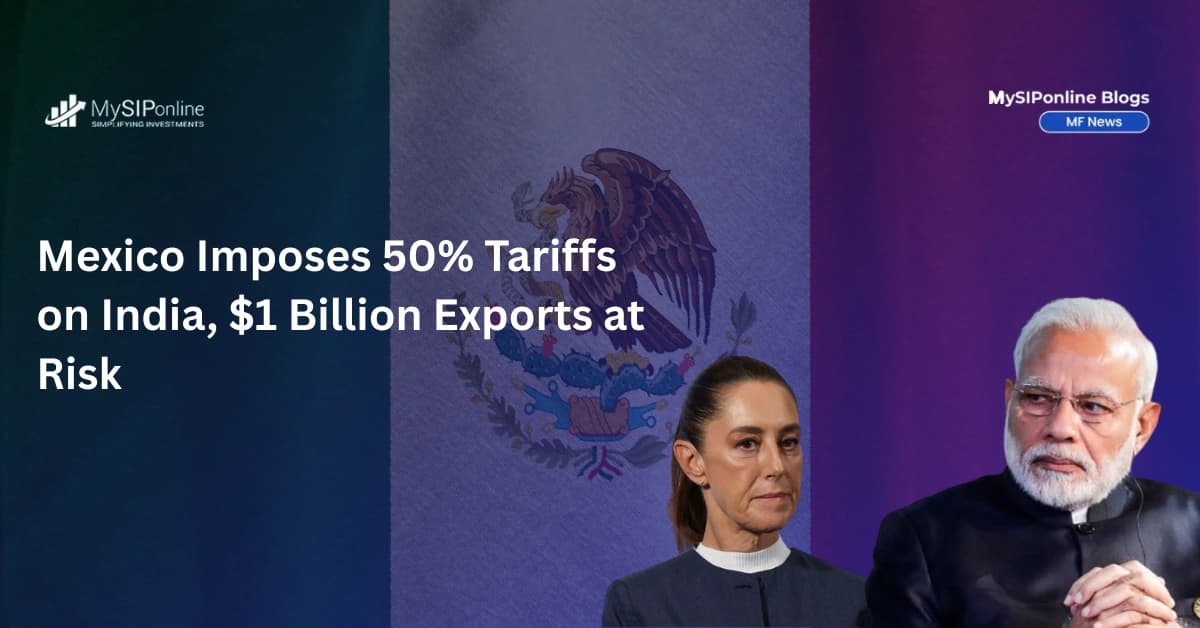Table of Contents
- Nippon India Flexi Cap Fund Review
- Performance Analysis of Nippon India Flexi Cap Fund
- Investment Strategy of Nippon India Flexi Cap Fund
- Portfolio Composition of Nippon India Flexi Cap Fund
- Nippon India Flexi Cap Fund Stock Quality and Risk Analysis
- Who is the Fund Manager of Nippon India Flexi Cap Fund?
- Who Should Invest in the Nippon India Flexi Cap Fund in 2025?
- Conclusion
Did you know that the Nippon India Flexi Cap Fund has generated the best returns in its category for 3 years and that its AUM crossed Rs 9,500 crore, marking a new asset milestone? Impressive, right? But that is not all, some industry trackers have praised its market outperformance and robust stock selection, making it a finalist in national mutual fund rankings for best risk-adjusted returns and portfolio innovation. All these achievements and solid growth history make it a top pick for your 2025 investment in mutual funds.
This fund allows you to invest in a diversified portfolio of large, mid and small-cap companies, helping you build wealth over time. Still confused about whether you should invest in this Fund? Then dive into this Nippon India Flexi Cap Fund Review and see how it stacks up for savvy investors like you in 2025.
Nippon India Flexi Cap Fund Review
The Nippon India Flexi Cap Fund, introduced by Nippon Mutual Fund, is a diversified equity mutual fund that invests across large, mid and small-cap stocks for long-term growth. Both regular and direct plans of this fund offer a blend of stability and growth potential to the investors with a long-term vision.
The fund carries a moderate to high risk profile, suitable for individuals who are comfortable with market volatility and seeking growth. Nippon Life India Asset Management Limited launched this fund on August 13, 2021, and as of 2025, the fund manages an AUM (Assets Under Management) of Rs 9,573 Crore. The mutual fund is benchmarked against NIFTY 500 TRI, which has a NAV of Rs 17.98 (as of November 21, 2025).
This Flexi Cap Mutual Funds has an expense ratio of 0.45%, an exit load of 1.0% (with no lock-in period), a minimum SIP investment of Rs 500 and a minimum lump sum investment of Rs 1000. It stands as a cost-effective, well-ranked option among flexi cap funds for long-term investors in 2025.
Now, let us analyse the performance of this fund and see how it performed in the past years.
Performance Analysis of Nippon India Flexi Cap Fund
Here is the detailed performance analysis of the Nippon India Flexi Cap Fund, based on:
Rolling Returns
Nippon India Flexi Cap Fund stands out with a 3-year rolling return of 17.53%, beating the benchmark index at 16.27%. Its consistency score is also impressive at 99.34%, which means it regularly delivers strong returns across market cycles, surpassing the index at 97.72%.
The above graph shows that the fund is well-managed and is growing on market opportunities while controlling risk.
SIP Returns
Nippon India Flexi Cap Fund has posted a 3-year SIP return of 13.2%, trailing both the category average of 14.46% and the benchmark at 15.84%, showing that the fund has taken a relatively cautious approach compared to pure small-cap strategies.
The above graph shows that while the fund has not led performance in the recent cycle, it may offer better risk control and stability in the long term.
Pro Tip: Use a SIP Calculator and estimate the future returns of your SIP investment easily.
Let us understand the fund's investment style in the next part.
Investment Strategy of Nippon India Flexi Cap Fund
The main investment philosophy of the Nippon India Flexi Cap Fund is to achieve long-term capital appreciation and wealth creation by dynamically investing across large, mid and small-cap stocks. This fund prioritizes flexibility to maximize returns while reducing risks through diversification in different market caps.
The investment approach of this flexi-cap fund allows you to invest in a wide range of companies, blending both growth and value opportunities without strict limits on company size. It aims to identify undervalued leaders with strong fundamentals. For its research process, the fund uses a bottom-up approach for stock selection and a top-down approach for sector and macro analysis.
The fund includes 87 stocks and has about 34% of its investments in its top 10 holdings. It has a moderate portfolio turnover rate of 33%, indicating a focus on long-term investments. It is best used as a smaller portion of an investment portfolio, making up about 15-25%, helping investors achieve growth while keeping risks manageable for long-term gains.
Must Read: Top 10 Flexi Cap Mutual Funds: High-Return Picks in India 2025
In the next part, you will review the fund's portfolio composition.
Portfolio Composition of Nippon India Flexi Cap Fund
Here is the breakdown of the portfolio composition on the Nippon India Flexi Cap Fund:
Asset Allocation
Nippon India Flexi Cap Fund maintains an equity allocation of 98.78%, showing its strong commitment to growth potential. The fund has very little debt, only 0.01%, showing its focus on earning money through stocks. It also has a small cash and equivalents balance of 1.21%, which helps manage liquidity and handle market changes.
This investment strategy aims to achieve higher returns in a growing market while remaining flexible.
Market Cap Allocation
Nippon India Flexi Cap Fund invests nearly 79% of its assets in large-cap stocks for stability and growth, 18.4% in mid-cap stocks for higher returns from growth companies and 2.68% in small-cap stocks for potential outperformance while keeping overall volatility manageable.
This market-cap allocation provides balance, making the fund a great choice for building long-term wealth.
Sector Allocation
Nippon India Flexi Cap Fund smartly spreads its investments across multiple sectors. Financials (27.41%) provide stability, technology (16.71%) and consumer sectors add growth. The fund stays ahead of peers in tech and staples for long-term returns with less risk from market ups and downs.
This sector mix helps the fund to beat market cycles while taking advantage of new opportunities in India’s evolving market.
Start Your SIP TodayLet your money work for you with the best SIP plans.
Now, let us analyse the fund's stock quality and risk measures.
Nippon India Flexi Cap Fund Stock Quality and Risk Analysis
The Nippon India Flexi Cap Fund's risk and stock analysis reveals a diversified portfolio, though it carries some notable risks. Here is the analysis of the fund:
Stock Quality Analysis
Nippon India Flexi Cap Fund holds stocks with a price-to-earnings (P/E) ratio of 24.23. The fund's earnings growth is 15.87%, sales growth is 13.71% and cash flow growth is 6.68%, displaying strong business fundamentals and liquidity
| Fundamental Ratios | Values |
|---|---|
| Sales Growth | 13.71% |
| Earnings Growth | 15.87% |
| Cash Flow Growth | 6.68% |
| P/E Ratio (Valuations) | 24.23 |
These factors point to solid stock selection by the fund manager, aiming for steady value and growth.
Risk Measures
Nippon India Flexi Cap Fund manages risk reasonably well compared to its category average. Its standard deviation (12.85%) is slightly lower; the Sharpe ratio (0.73) is also close to the average; alpha is lower at 0.4; and beta (0.94) is almost on par with the category. The maximum loss is -19.11%, which means the fund could drop more in weak markets.
The fund carries moderate risk but delivers reliable returns, as shown in the above graph.
Also Read: Top 10 Mutual Funds for SIP in 2025: Best Picks to Grow Wealth
You will learn about the fund managers in the next section.
Who is the Fund Manager of Nippon India Flexi Cap Fund?
The two masterminds behind the successful implementations of all the strategies are Meenakshi Dawar and Dhrumil Shah, a collaborative team with expertise in multi-cap equity management. Let us break down the profiles of these two leaders separately:
Dhrumil Shah
He has been the lead manager of this fund since its inception (August 2021). He is a PGDM holder with a background in equity research and fund management. At this fund house, he manages three schemes that focus on growth opportunities in different market sizes. His leadership strengthens the fund’s flexible, research-based approach.
Meenakshi Dawar
She has been a co-manager of Nippon India Flexi Cap Fund since January 2023. She focuses on value and hybrid strategies and manages multiple equity schemes at Nippon India Mutual Fund. At this fund house, she manages three open-ended funds, bringing experience in dynamic portfolio allocations.
Now, the main question: Should you invest in the Nippon India Flexi Cap Fund? Keep reading to know.
Who Should Invest in the Nippon India Flexi Cap Fund in 2025?
In 2025, the Nippon India Flexi Cap Fund is highly suitable for the following investors who:
- Have a Long-Term Investment Horizon
You should have an investment horizon of at least 3-5 years to overcome market volatility and achieve long-term growth.
- Are Seeking Diversified Growth
It is suitable for you if you are looking for stability from large caps and high growth from mid and small-caps.
- Have a High-Risk Tolerance
It can be a smart move for your future if you are prepared for a few losses and market fluctuations in the short to medium term.
The fund is suitable for an aggressive long-term investor seeking diversified growth, but not for conservative investors or those with a short-term financial goal.
Smart Investments, Bigger Returns
Conclusion
To wrap up, the Nippon India Flexi Cap Fund are mutual funds that helps you grow your wealth over the long term by allowing you to invest in a diversified portfolio of large, mid and small cap stocks. The fund has the potential to generate higher returns over time.
However, the fund also has moderate to high risk, making it suitable for investors who want to build wealth over time and can handle some market fluctuations.
Related Blogs:
1. Best SIP Plan for 20 Years: With Equity, Debt & Hybrid Funds
2. Best Mutual Funds to Invest in 2025: Low-Risk Options for High Return
FAQs
1. How is this fund different?
You get broader diversification and solid returns, starting with less money than most other funds.
2. Is there an exit load or lock-in?
There is no lock-in period. You can exit at any time, but if you withdraw within a year, you will pay a 1% fee.
3. What do experts say for 2025?
They like the low fees and balanced risk, and they think it is excellent for steady, long-term growth.
4. How risky is it?
It is high risk due to mid- and small-cap stocks. But smart diversification helps even things out.
5. What does it invest in?
It primarily invests in financials, tech, consumer goods and healthcare, so it mixes stability with growth potential.




(1).webp&w=3840&q=75)





.webp&w=3840&q=75)




